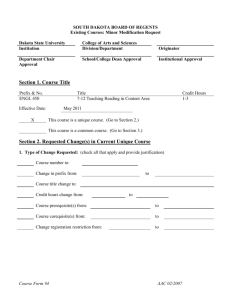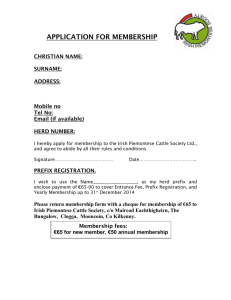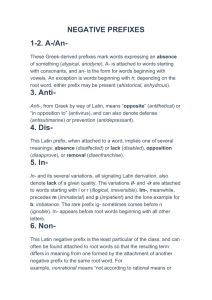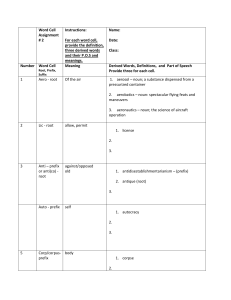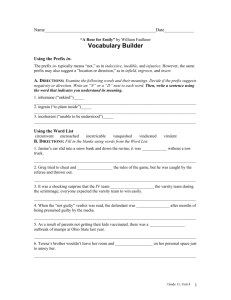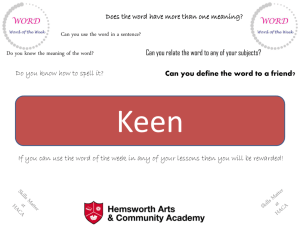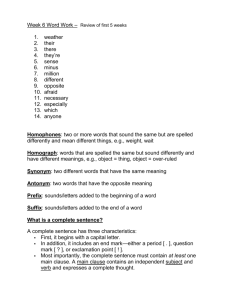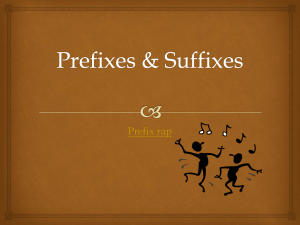Morphophonemics • determining underlying forms • rule
advertisement
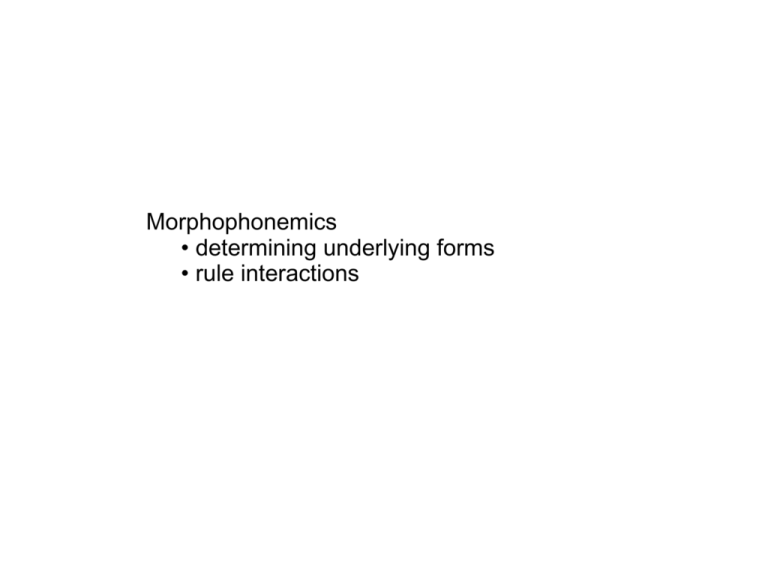
Morphophonemics • determining underlying forms • rule interactions Kikuyu What is the underlying form of the infinitive prefix in Kikuyu? Give a rule that explains the non-underlying pronunciation of the prefix. (Odden, 2005) ɣotɛŋɛra ‘to run’ ‘to carry’ ɣokoora ɣokuua ‘to root out’ koruɣa ‘to cook’ kooria ‘to ask’ komɛɲa ‘to know’ kohɔta ‘to be able’ ɣoʧina ‘to burn’ koɣeera koniina ɣoʧuuka ‘to fetch’ ‘to finish’ ‘to slander’ kohetoka koina ɣokaya ‘to pass’ ‘to dance’ ‘to cut’ koɣaya ‘to divide’ Kikuyu What is the underlying form of the infinitive prefix in Kikuyu? Give a rule that explains the non-underlying pronunciation of the prefix. (Odden, 2005) ɣotɛŋɛra ‘to run’ ‘to carry’ ɣokoora ɣokuua ‘to root out’ koruɣa ‘to cook’ kooria ‘to ask’ komɛɲa ‘to know’ kohɔta ‘to be able’ ɣoʧina ‘to burn’ koɣeera koniina ɣoʧuuka ‘to fetch’ ‘to finish’ ‘to slander’ kohetoka koina ɣokaya ‘to pass’ ‘to dance’ ‘to cut’ koɣaya ‘to divide’ Look at how the stem starts with each prefix: ko – o, h, ɣ, n, r, m, i Kikuyu What is the underlying form of the infinitive prefix in Kikuyu? Give a rule that explains the non-underlying pronunciation of the prefix. (Odden, 2005) ɣotɛŋɛra ‘to run’ ‘to carry’ ɣokoora ɣokuua ‘to root out’ koruɣa ‘to cook’ kooria ‘to ask’ komɛɲa ‘to know’ kohɔta ‘to be able’ ɣoʧina ‘to burn’ koɣeera koniina ɣoʧuuka ‘to fetch’ ‘to finish’ ‘to slander’ kohetoka koina ɣokaya ‘to pass’ ‘to dance’ ‘to cut’ koɣaya ‘to divide’ Look at how the stem starts with each prefix: ko – o, h, ɣ, n, r, i ɣo – t, k, ʧ Kikuyu What is the underlying form of the infinitive prefix in Kikuyu? Give a rule that explains the non-underlying pronunciation of the prefix. (Odden, 2005) ɣotɛŋɛra ‘to run’ ‘to carry’ ɣokoora ɣokuua ‘to root out’ koruɣa ‘to cook’ kooria ‘to ask’ komɛɲa ‘to know’ kohɔta ‘to be able’ ɣoʧina ‘to burn’ koɣeera koniina ɣoʧuuka ‘to fetch’ ‘to finish’ ‘to slander’ kohetoka koina ɣokaya ‘to pass’ ‘to dance’ ‘to cut’ koɣaya ‘to divide’ Look at how the stem starts with each prefix: ko – o, h, ɣ, n, r, i ɣo – t, k, ʧ Dissimilation: ko -> ɣo/ ___t,k,ʧ [-cont] -> [+cont]/ ____ [-cont] We come to an analysis of morphophonological alternations just as we did in case of allophony by focussing on distributions – the contexts within which variants occur. ko – o, h, ɣ, n, r, i ɣo – t, k, ʧ Dissimilation: ko -> ɣo/ ___t,k,ʧ [-cont] -> [+cont]/ ____ [-cont] One diference is that we are analyzing phonetic variants of morphemes – not patterns in unrelated phonetic forms. Phonetic form varies while meaning remains constant. Thus, phonetically unnatural relationships may be sustained – meaning holds forms together. Palauan. Underlying form ≠ any surface form. pre s . m id. mədáŋəb məteʔəb məŋetəm mətábək məʔarəm məsesəb f. innov. dəŋəbáll təʔəball ŋətəmáll təbəkáll ʔərəmall səsəball Identify some morphemes: • the present middle • the future tense • the innovative f. cons e rv. dəŋobl 'cover' təʔíbl 'pull out' ŋətoml 'lick' təbakl 'patch' ʔəroml 'taste' səsobl 'burn' Palauan. Underlying form ≠ any surface form. pre s . m id. mədáŋəb məteʔəb məŋetəm mətábək məʔarəm məsesəb f. innov. dəŋəbáll təʔəball ŋətəmáll təbəkáll ʔərəmall səsəball f. cons e rv. dəŋobl 'cover' təʔíbl 'pull out' ŋətoml 'lick' təbakl 'patch' ʔəroml 'taste' səsobl 'burn' Identify some morphemes: • the present middle mə• the future tense • the innovative Palauan. Underlying form ≠ any surface form. pre s . m id. mədáŋəb məteʔəb məŋetəm mətábək məʔarəm məsesəb f. innov. dəŋəbáll təʔəball ŋətəmáll təbəkáll ʔərəmall səsəball f. cons e rv. dəŋobl 'cover' təʔíbl 'pull out' ŋətoml 'lick' təbakl 'patch' ʔəroml 'taste' səsobl 'burn' Identify some morphemes: • the present middle mə• the future tense -l • the innovative Palauan. Underlying form ≠ any surface form. pre s . m id. mədáŋəb məteʔəb məŋetəm mətábək məʔarəm məsesəb f. innov. dəŋəbáll təʔəball ŋətəmáll təbəkáll ʔərəmall səsəball f. cons e rv. dəŋobl 'cover' təʔíbl 'pull out' ŋətoml 'lick' təbakl 'patch' ʔəroml 'taste' səsobl 'burn' Identify some morphemes: • the present middle mə• the future tense -l • the innovative -al Palauan. Underlying form ≠ any surface form. mə-all -l pre s . m id. f. innov. f. cons e rv. mədáŋəb dəŋəbáll dəŋobl 'cover' məteʔəb təʔəball təʔíbl 'pull out' məŋetəm ŋətəmáll ŋətoml 'lick' mətábək təbəkáll təbakl 'patch' məʔarəm ʔərəmall ʔəroml 'taste' məsesəb səsəball səsobl 'burn' What is the underlying form of 'cover'? Palauan. Underlying form ≠ any surface form. mə-all -l pre s . m id. f. innov. f. cons e rv. mədáŋəb dəŋəbáll dəŋobl 'cover' məteʔəb təʔəball təʔíbl 'pull out' məŋetəm ŋətəmáll ŋətoml 'lick' mətábək təbəkáll təbakl 'patch' məʔarəm ʔərəmall ʔəroml 'taste' məsesəb səsəball səsobl 'burn' What is the underlying form of 'cover'? compare pres. mid. and f. innov. forms - posit /daŋəb/ - a stress assignment rule (penult stress, final superheavy stress) plus a rule: V -> ə/ _____ (unstressed vowel reduction) [-stress] Palauan. Underlying form ≠ any surface form. mə-all -l pre s . m id. f. innov. f. cons e rv. mədáŋəb dəŋəbáll dəŋobl 'cover' məteʔəb təʔəball təʔíbl 'pull out' məŋetəm ŋətəmáll ŋətoml 'lick' mətábək təbəkáll təbakl 'patch' məʔarəm ʔərəmall ʔəroml 'taste' məsesəb səsəball səsobl 'burn' What is the underlying form of 'cover'? compare f. innov. and f. conserv. forms - posit /dəŋob/ again with the rule V[-stress] -> ə Palauan. Underlying form ≠ any surface form. mə-all -l pre s . m id. f. innov. f. cons e rv. unde rlying form mədáŋəb dəŋəbáll dəŋobl 'cover' məteʔəb təʔəball təʔíbl 'pull out' məŋetəm ŋətəmáll ŋətoml 'lick' mətábək təbəkáll təbakl 'patch' məʔarəm ʔərəmall ʔəroml 'taste' məsesəb səsəball səsobl 'burn' daŋob teʔib ŋetom tabak ʔarom sesob The underlying forms of these verb meanings never appear in any single surface form. What are the underlying forms of these words? monotone – monotonic telegraph – telegraphy epigraph – epigraphy relative – relation economy – economic defect – defective democrat – democracy Italy – Italian homonym – homonymy phonetics - phonetician phonology - phonological We have seen that morphophonemic analysis: - involves distributions of morphologically related variants. - may require that we posit the existence of abstract forms (never heard in any production). - may require that we posit the existence of interacting processes. Polish. What phonological rules are motivated by the following examples, and what order do the rules apply in? (Odden, 2005, p. 122) sg. klup dom ʒwup dzvon lut nos wuk sok bur sul ʃum pl. klubi domi ʒwobi dzvoni lodi nosi wugi soki bori soli ʃumi ‘club’ ‘house’ ‘crib’ ‘bell’ ‘ice’ ‘nose’ ‘lye’ ‘juice’ ‘forest’ ‘salt’ ‘noise’ sg. trup snop trut kot grus vus wuk ruk vuw buy ʒur pl. trupi snopi trudi koti gruzi vozi wuki rogi vowi boyi ʒuri ‘corpse’ ‘sheaf’ ‘labor’ ‘cat’ ‘rubble’ ‘cart’ ‘bow’ ‘horn’ ‘ox’ ‘fight’ ‘soup’ Polish. What phonological rules are motivated by the following examples, and what order do the rules apply in? (Odden, 2005, p. 122) sg. klup dom ʒwup dzvon lut nos wuk sok bur sul ʃum pl. klubi domi ʒwobi dzvoni lodi nosi wugi soki bori soli ʃumi ‘club’ ‘house’ ‘crib’ ‘bell’ ‘ice’ ‘nose’ ‘lye’ ‘juice’ ‘forest’ ‘salt’ ‘noise’ The plural ending is -i sg. trup snop trut kot grus vus wuk ruk vuw buy ʒur pl. trupi snopi trudi koti gruzi vozi wuki rogi vowi boyi ʒuri ‘corpse’ ‘sheaf’ ‘labor’ ‘cat’ ‘rubble’ ‘cart’ ‘bow’ ‘horn’ ‘ox’ ‘fight’ ‘soup’ Polish. What phonological rules are motivated by the following examples, and what order do the rules apply in? (Odden, 2005, p. 122) sg. klup dom ʒwup dzvon lut nos wuk sok bur sul ʃum pl. klubi domi ʒwobi dzvoni lodi nosi wugi soki bori soli ʃumi ‘club’ ‘house’ ‘crib’ ‘bell’ ‘ice’ ‘nose’ ‘lye’ ‘juice’ ‘forest’ ‘salt’ ‘noise’ sg. trup snop trut kot grus vus wuk ruk vuw buy ʒur pl. trupi snopi trudi koti gruzi vozi wuki rogi vowi boyi ʒuri ‘corpse’ ‘sheaf’ ‘labor’ ‘cat’ ‘rubble’ ‘cart’ ‘bow’ ‘horn’ ‘ox’ ‘fight’ ‘soup’ The stem vowel alternates (in some forms) between [u] in the singular and [o] in the plural. Can you come up with a rule? Polish. What phonological rules are motivated by the following examples, and what order do the rules apply in? (Odden, 2005, p. 122) sg. klup dom ʒwup dzvon lut nos wuk sok bur sul ʃum pl. klubi domi ʒwobi dzvoni lodi nosi wugi soki bori soli ʃumi ‘club’ ‘house’ ‘crib’ ‘bell’ ‘ice’ ‘nose’ ‘lye’ ‘juice’ ‘forest’ ‘salt’ ‘noise’ sg. trup snop trut kot grus vus wuk ruk vuw buy ʒur pl. trupi snopi trudi koti gruzi vozi wuki rogi vowi boyi ʒuri ‘corpse’ ‘sheaf’ ‘labor’ ‘cat’ ‘rubble’ ‘cart’ ‘bow’ ‘horn’ ‘ox’ ‘fight’ ‘soup’ The final consonant of the stem (in some forms) alternates between [+voi] and [-voi]. Polish. What phonological rules are motivated by the following examples, and what order do the rules apply in? (Odden, 2005, p. 122) sg. klup dom ʒwup dzvon lut nos wuk sok bur sul ʃum pl. klubi domi ʒwobi dzvoni lodi nosi wugi soki bori soli ʃumi ‘club’ ‘house’ ‘crib’ ‘bell’ ‘ice’ ‘nose’ ‘lye’ ‘juice’ ‘forest’ ‘salt’ ‘noise’ sg. trup snop trut kot grus vus wuk ruk vuw buy ʒur pl. trupi snopi trudi koti gruzi vozi wuki rogi vowi boyi ʒuri ‘corpse’ ‘sheaf’ ‘labor’ ‘cat’ ‘rubble’ ‘cart’ ‘bow’ ‘horn’ ‘ox’ ‘fight’ ‘soup’ Final devoicing: obstruents must be voiceless at the ends of words C [-son] -> [-voi]/ __# Polish. What phonological rules are motivated by the following examples, and what order do the rules apply in? (Odden, 2005, p. 122) klub -> wug -> sg. klup dom ʒwup dzvon lut nos wuk sok bur sul ʃum pl. klubi domi ʒwobi dzvoni lodi nosi wugi soki bori soli ʃumi ‘club’ ‘house’ ‘crib’ ‘bell’ ‘ice’ ‘nose’ ‘lye’ ‘juice’ ‘forest’ ‘salt’ ‘noise’ sg. trup snop trut kot grus vus wuk ruk vuw buy ʒur pl. trupi snopi trudi koti gruzi vozi wuki rogi vowi boyi ʒuri ‘corpse’ ‘sheaf’ ‘labor’ <- trud ‘cat’ ‘rubble’ <‘cart’ gruz ‘bow’ ‘horn’ ‘ox’ ‘fight’ ‘soup’ Final devoicing: obstruents must be voiceless at the ends of words C [-son] -> [-voi]/ __# Polish. What phonological rules are motivated by the following examples, and what order do the rules apply in? (Odden, 2005, p. 122) sg. klup dom ʒwup dzvon lut nos wuk sok bur sul ʃum pl. klubi domi ʒwobi dzvoni lodi nosi wugi soki bori soli ʃumi ‘club’ ‘house’ ‘crib’ ‘bell’ ‘ice’ ‘nose’ ‘lye’ ‘juice’ ‘forest’ ‘salt’ ‘noise’ sg. trup snop trut kot grus vus wuk ruk vuw buy ʒur pl. trupi snopi trudi koti gruzi vozi wuki rogi vowi boyi ʒuri ‘corpse’ ‘sheaf’ ‘labor’ ‘cat’ ‘rubble’ ‘cart’ ‘bow’ ‘horn’ ‘ox’ ‘fight’ ‘soup’ Consider again the [u]/[o] alternation. How do the stems end? Polish. What phonological rules are motivated by the following examples, and what order do the rules apply in? (Odden, 2005, p. 122) sg. klup dom ʒwup dzvon lut nos wuk sok bur sul ʃum pl. klubi domi ʒwobi dzvoni lodi nosi wugi soki bori soli ʃumi ‘club’ ‘house’ ‘crib’ ‘bell’ ‘ice’ ‘nose’ ‘lye’ ‘juice’ ‘forest’ ‘salt’ ‘noise’ sg. trup snop trut kot grus vus wuk ruk vuw buy ʒur pl. trupi snopi trudi koti gruzi vozi wuki rogi vowi boyi ʒuri ‘corpse’ ‘sheaf’ ‘labor’ ‘cat’ ‘rubble’ ‘cart’ ‘bow’ ‘horn’ ‘ox’ ‘fight’ ‘soup’ Consider again the [u]/[o] alternation. How do the stems end? They are all voiced in the underlying representation! Polish. What phonological rules are motivated by the following examples, and what order do the rules apply in? (Odden, 2005, p. 122) sg. klup dom ʒwup dzvon lut nos wuk sok bur sul ʃum pl. klubi domi ʒwobi dzvoni lodi nosi wugi soki bori soli ʃumi ‘club’ ‘house’ ‘crib’ ‘bell’ ‘ice’ ‘nose’ ‘lye’ ‘juice’ ‘forest’ ‘salt’ ‘noise’ sg. trup snop trut kot grus vus wuk ruk vuw buy ʒur pl. trupi snopi trudi koti gruzi vozi wuki rogi vowi boyi ʒuri ‘corpse’ ‘sheaf’ ‘labor’ ‘cat’ ‘rubble’ ‘cart’ ‘bow’ ‘horn’ ‘ox’ ‘fight’ ‘soup’ Alternative 1: /u/ -> /o/ before voiced consonants in the plural Polish. What phonological rules are motivated by the following examples, and what order do the rules apply in? (Odden, 2005, p. 122) no sg. klup dom ʒwup dzvon lut nos wuk sok bur sul ʃum pl. klubi domi ʒwobi dzvoni lodi nosi wugi soki bori soli ʃumi ‘club’ ‘house’ ‘crib’ ‘bell’ ‘ice’ ‘nose’ ‘lye’ ‘juice’ ‘forest’ ‘salt’ ‘noise’ sg. trup snop trut kot grus vus wuk ruk vuw buy ʒur pl. trupi snopi trudi koti gruzi vozi wuki rogi vowi boyi ʒuri ‘corpse’ ‘sheaf’ ‘labor’ ‘cat’ ‘rubble’ ‘cart’ ‘bow’ ‘horn’ ‘ox’ ‘fight’ ‘soup’ Alternative 1: /u/ -> /o/ before voiced consonants in the plural Polish. What phonological rules are motivated by the following examples, and what order do the rules apply in? (Odden, 2005, p. 122) no sg. klup dom ʒwup dzvon lut nos wuk sok bur sul ʃum pl. klubi domi ʒwobi dzvoni lodi nosi wugi soki bori soli ʃumi ‘club’ ‘house’ ‘crib’ ‘bell’ ‘ice’ ‘nose’ ‘lye’ ‘juice’ ‘forest’ ‘salt’ ‘noise’ sg. trup snop trut kot grus vus wuk ruk vuw buy ʒur pl. trupi snopi trudi koti gruzi vozi wuki rogi vowi boyi ʒuri ‘corpse’ ‘sheaf’ ‘labor’ ‘cat’ ‘rubble’ ‘cart’ ‘bow’ ‘horn’ ‘ox’ ‘fight’ ‘soup’ Alternative 2: /o/ -> [u] before voiced consonants in the singular Polish. What phonological rules are motivated by the following examples, and what order do the rules apply in? (Odden, 2005, p. 122) sg. klup dom ʒwup dzvon lut nos wuk sok bur sul ʃum pl. klubi domi ʒwobi dzvoni lodi nosi wugi soki bori soli ʃumi ‘club’ ‘house’ ‘crib’ ‘bell’ ‘ice’ ‘nose’ ‘lye’ ‘juice’ ‘forest’ ‘salt’ ‘noise’ sg. trup snop trut kot grus vus wuk ruk vuw buy ʒur pl. trupi snopi trudi koti gruzi vozi wuki rogi vowi boyi ʒuri ‘corpse’ ‘sheaf’ ‘labor’ ‘cat’ ‘rubble’ ‘cart’ ‘bow’ ‘horn’ ‘ox’ ‘fight’ ‘soup’ Alternative 2: /o/ -> [u] before voiced consonants in the singular Alternative 3: /o/ -> [u] /___C[+voi,-nas]# /o/ -> [u] /___C[+voi,-nas]# C [-son] -> [-voi]/ __# /lod/ /snop/ /dom/ /klub/ [lud] ---[lut] --[klup] Indonesian verb prefixes – what form will the prefix take? (Clements & Halle, 1983, A Problem Book in Phonology.) 1. 2. 3. 4. 5. 6. 7. 8. 9. 10. 11. 12. 13. 14. 15. 16. 17. 18. 19. 20. throw lempar feel rasa represent wakil convince yakin cook masak marry nikah chat ŋaco sing ɲaɲi count hituŋ draw a picture gambar send kirim hear dəŋar write tulis help bantu hit pukul sew ʤahit note down ʧatat take ambil fill up isi invite undaŋ məlempar mərasa məwakili məyakini məmasak mənikah məŋaco məɲaɲi məŋhituŋ məŋgambar məŋirim məndəŋar mənulis məmbantu məmukul məɲʤahit məɲʧatat məŋambil məŋisi məŋundaŋ Indonesian verb prefixes – what form will the prefix take? (Clements & Halle, 1983, A Problem Book in Phonology.) 1. 2. 3. 4. 5. 6. 7. 8. throw feel represent convince cook marry chat sing lempar rasa wakil yakin masak nikah ŋaco ɲaɲi 9. 10. 11. 12. 13. 14. 15. 16. 17. 18. 19. 20. count hituŋ draw a picture gambar send kirim hear dəŋar write tulis help bantu hit pukul sew ʤahit note down ʧatat take ambil fill up isi invite undaŋ məlempar mərasa məwakili məyakini məmasak mənikah məŋaco məɲaɲi məŋhituŋ məŋgambar məŋirim məndəŋar mənulis məmbantu məmukul məɲʤahit məɲʧatat məŋambil məŋisi məŋundaŋ Is the prefix is [mə-] Indonesian verb prefixes – what form will the prefix take? (Clements & Halle, 1983, A Problem Book in Phonology.) 1. 2. 3. 4. 5. 6. 7. 8. throw feel represent convince cook marry chat sing lempar rasa wakil yakin masak nikah ŋaco ɲaɲi 9. 10. 11. 12. 13. 14. 15. 16. 17. 18. 19. 20. count hituŋ draw a picture gambar send kirim hear dəŋar write tulis help bantu hit pukul sew ʤahit note down ʧatat take ambil fill up isi invite undaŋ məlempar mərasa məwakili məyakini məmasak mənikah məŋaco məɲaɲi məŋhituŋ məŋgambar məŋirim məndəŋar mənulis məmbantu məmukul məɲʤahit məɲʧatat məŋambil məŋisi məŋundaŋ Or is it [məN-]? Indonesian verb prefixes – what form will the prefix take? (Clements & Halle, 1983, A Problem Book in Phonology.) 1. 2. 3. 4. 5. 6. 7. 8. throw feel represent convince cook marry chat sing lempar rasa wakil yakin masak nikah ŋaco ɲaɲi 9. 10. 11. 12. 13. 14. 15. 16. 17. 18. 19. 20. count hituŋ draw a picture gambar send kirim hear dəŋar write tulis help bantu hit pukul sew ʤahit note down ʧatat take ambil fill up isi invite undaŋ məlempar mərasa məwakili məyakini məmasak mənikah məŋaco məɲaɲi məŋhituŋ məŋgambar məŋirim məndəŋar mənulis məmbantu məmukul məɲʤahit məɲʧatat məŋambil məŋisi məŋundaŋ N → ø/ ___ [+cons, +son] Or is it [məN-]? YES A deletion rule is simpler than an insertion rule in this case. Indonesian verb prefixes – what form will the prefix take? (Clements & Halle, 1983, A Problem Book in Phonology.) 1. 2. 3. 4. 5. 6. 7. 8. throw feel represent convince cook marry chat sing lempar rasa wakil yakin masak nikah ŋaco ɲaɲi 9. 10. 11. 12. 13. 14. 15. 16. 17. 18. 19. 20. count hituŋ draw a picture gambar send kirim hear dəŋar write tulis help bantu hit pukul sew ʤahit note down ʧatat take ambil fill up isi invite undaŋ məlempar mərasa məwakili məyakini məmasak mənikah məŋaco məɲaɲi məŋhituŋ məŋgambar məŋirim məndəŋar mənulis məmbantu məmukul məɲʤahit məɲʧatat məŋambil məŋisi məŋundaŋ Underlying form of the prefix? məŋ- mən- məɲ- məN- Indonesian verb prefixes – what form will the prefix take? (Clements & Halle, 1983, A Problem Book in Phonology.) 1. 2. 3. 4. 5. 6. 7. 8. throw feel represent convince cook marry chat sing lempar rasa wakil yakin masak nikah ŋaco ɲaɲi 9. 10. 11. 12. 13. 14. 15. 16. 17. 18. 19. 20. count hituŋ draw a picture gambar send kirim hear dəŋar write tulis help bantu hit pukul sew ʤahit note down ʧatat take ambil fill up isi invite undaŋ məlempar mərasa məwakili məyakini məmasak mənikah məŋaco məɲaɲi məŋhituŋ məŋgambar məŋirim məndəŋar mənulis məmbantu məmukul məɲʤahit məɲʧatat məŋambil məŋisi məŋundaŋ Underlying form of the prefix? məŋ- mən- məɲ- məNThe place of the nasal matches the following consonant – but when there isn't a following consonant the prefix is [məŋ-] Indonesian verb prefixes – what form will the prefix take? (Clements & Halle, 1983, A Problem Book in Phonology.) 1. 2. 3. 4. 5. 6. 7. 8. throw feel represent convince cook marry chat sing lempar rasa wakil yakin masak nikah ŋaco ɲaɲi 9. 10. 11. 12. 13. 14. 15. 16. 17. 18. 19. 20. count hituŋ draw a picture gambar send kirim hear dəŋar write tulis help bantu hit pukul sew ʤahit note down ʧatat take ambil fill up isi invite undaŋ məlempar mərasa məwakili məyakini məmasak mənikah məŋaco məɲaɲi məŋhituŋ məŋgambar məŋirim məndəŋar mənulis məmbantu məmukul məɲʤahit məɲʧatat məŋambil məŋisi məŋundaŋ Underlying form of the prefix? məŋ- mən- məɲ- məNThe place of the nasal matches the following consonant – but when there isn't a following consonant the prefix is [məŋ-]. ŋ → place/ ___ place Indonesian verb prefixes – what form will the prefix take? (Clements & Halle, 1983, A Problem Book in Phonology.) 1. 2. 3. 4. 5. 6. 7. 8. throw feel represent convince cook marry chat sing lempar rasa wakil yakin masak nikah ŋaco ɲaɲi 9. 10. 11. 12. 13. 14. 15. 16. 17. 18. 19. 20. count hituŋ draw a picture gambar send kirim hear dəŋar write tulis help bantu hit pukul sew ʤahit note down ʧatat take ambil fill up isi invite undaŋ məlempar mərasa məwakili məyakini məmasak mənikah məŋaco məɲaɲi məŋhituŋ məŋgambar məŋirim məndəŋar mənulis məmbantu məmukul məɲʤahit məɲʧatat məŋambil məŋisi məŋundaŋ ŋ → place/ ___ place Initial [p], [t], and [k] are deleted in these prefixed forms. [p t k] → ø/ [+nas] ______ - but note the place of the final consonant in the prefix Indonesian verb prefixes – what form will the prefix take? (Clements & Halle, 1983, A Problem Book in Phonology.) 1. 2. 3. 4. 5. 6. 7. 8. throw feel represent convince cook marry chat sing lempar rasa wakil yakin masak nikah ŋaco ɲaɲi 9. 10. 11. 12. 13. 14. 15. 16. 17. 18. 19. 20. count hituŋ draw a picture gambar send kirim hear dəŋar write tulis help bantu hit pukul sew ʤahit note down ʧatat take ambil fill up isi invite undaŋ məlempar mərasa məwakili məyakini məmasak mənikah məŋaco məɲaɲi məŋhituŋ məŋgambar məŋirim məndəŋar mənulis məmbantu məmukul məɲʤahit məɲʧatat məŋambil məŋisi məŋundaŋ Rule order: 1. Assimilate the prefix nasal: ŋ → place/ ___ place 2. Then delete the trigger of the assimilation: [p t k] → ø/ [+nas] ______
